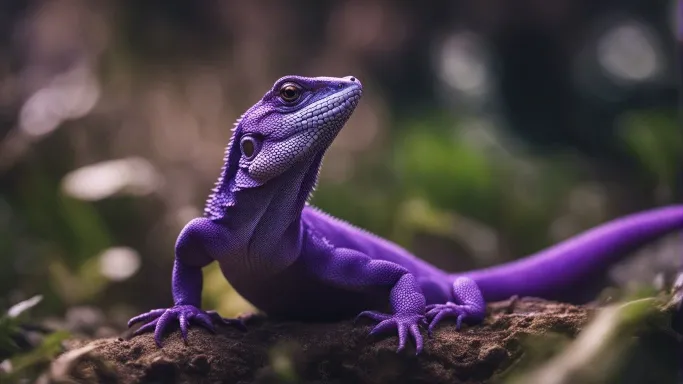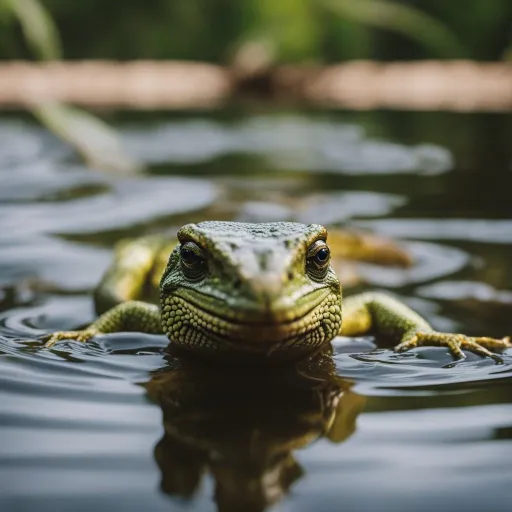Imagine you’re walking through a lush forest, and suddenly, you spot a lizard gracefully camouflaged among the vibrant leaves.
As you observe this incredible creature, a thought pops into your mind: can lizards change color?
In this article, we’ll explore the fascinating world of lizards and discover the truth behind this age-old question.
Get ready to uncover the secrets of their remarkable ability to blend seamlessly into their surroundings.

Overview
Lizards are fascinating reptiles known for their ability to change color. This unique feature sets them apart from other animals and serves various essential functions.
Understanding the mechanisms behind lizard color change and exploring its purposes can provide valuable insights into their biology and behavior.
In this article, we will delve into the definition of lizards, the importance of color change, the types of lizards that can change color, and much more.
Definition of Lizards
Lizards are a diverse group of reptiles belonging to the order Squamata, which also includes snakes and amphisbaenians. They are characterized by their scaly skin, elongated bodies, external ear openings, and typically four legs. With over 6,000 recognized species, lizards can be found in various habitats worldwide, from arid deserts to lush rainforests. While many lizards have fixed coloration, there are several species capable of changing their hues and patterns.
Definition and Importance of Color Change
Color change refers to the ability of certain lizards to alter their skin coloration, ranging from subtle variations to more dramatic transformations. This phenomenon plays a crucial role in their survival, allowing them to adapt to their environment, avoid predators, communicate with others, regulate body temperature, and establish dominance. By adjusting their appearance, lizards can blend into their surroundings, surprise their prey, and signal their intentions to conspecifics.
Types of Lizards That Can Change Color
Several types of lizards exhibit the fascinating ability to change color. Anolis lizards, commonly found in the Americas, are known for their rapid and extensive color transformations. Chameleons, mostly found in Africa and Madagascar, are famous for their iconic ability to change both color and pattern. Skinks, a diverse family of lizards found worldwide, possess partial color change capabilities. Lastly, geckos, known for their unique adhesive toe pads, have limited color-changing abilities compared to other lizard species.
Biological Mechanism
Physiological Adaptations for Color Change
Lizards have evolved various physiological adaptations that enable them to change color. These include specialized skin cells, called chromatophores, as well as intricate muscular and neural mechanisms. These adaptations allow lizards to adjust the distribution of pigments within their skin, altering their coloration in response to external stimuli.
Role of Melanin and Pigment Cells
Melanin, a pigment found in animal tissues, plays a crucial role in lizard color change. Lizards possess different types of pigment cells, such as melanophores, xanthophores, and erythrophores, which contain specific pigments responsible for various colors. The distribution and concentration of these pigment cells determine the overall coloration of the lizard’s skin.
Influence of Hormones
Hormones, particularly melanocyte-stimulating hormones (MSHs), play a significant role in lizard color change. The secretion of MSHs by the pituitary gland is influenced by various factors, including light, temperature, and circadian rhythm. These hormones stimulate the activity of pigment cells, leading to changes in coloration.
Effects of Temperature and Environment
Temperature and environmental factors have a profound impact on lizard color change. Lizards’ ability to regulate their body temperature is crucial for maintaining optimal physiological functioning. Color change helps lizards absorb or reflect solar radiation, allowing them to regulate their body temperature effectively. Additionally, environmental cues, such as the presence of predators or the availability of suitable substrates for camouflage, can trigger color changes in lizards.

Purpose of Color Change
Camouflage and Predator Avoidance
Camouflage is one of the primary purposes of lizard color change. By blending in with their surroundings, lizards can effectively hide from predators and increase their chances of survival. They can adjust their skin coloration to match the colors and patterns of their environment, making it difficult for predators to detect them.
Thermoregulation and Sun Exposure
Color change also plays a crucial role in the thermoregulation of lizards. By altering their skin color, lizards can either absorb or reflect sunlight, helping them regulate their body temperature. Darker colors absorb more heat, making them suitable for cooler environments, while lighter colors reflect heat, keeping the lizard cooler in hotter conditions.
Social Communication and Mating
Color change serves as a means of social communication among lizards. Bright or vibrant colors are often used to signal dominance, establish territory, or attract mates. By changing their skin color, lizards can convey information about their fitness, readiness to mate, and dominance hierarchy within their social group.
Marking Territories and Dominance
Lizards frequently use color change to mark their territories and assert dominance. By altering their coloration, lizards communicate their presence and territorial boundaries to competing conspecifics. This visual communication minimizes the need for physical confrontations, reducing the risk of injury.
Lizards’ Color Changing Abilities
Rapid Color Change in Anolis Lizards
Anolis lizards, also known as anoles, are renowned for their rapid and dramatic color changes. These lizards can alter their hues and patterns within seconds, making them highly adaptable to their surroundings. This ability helps them camouflage effectively and escape from predators.
Delayed Color Change in Chameleons
Chameleons are perhaps the most famous example of lizards that can change both color and pattern. Unlike anoles, chameleons change their color gradually over longer periods, often taking several minutes to complete the transformation. Their color changes are not solely a response to the environment but also reflect their internal physiological states and social interactions.
Partial Color Change in Skinks
Skinks, a diverse family of lizards, possess partial color change abilities. While they may not exhibit the dramatic transformations of anoles or the precise control of chameleons, skinks can adjust their skin color to some extent. This partial color change allows them to blend in with their surroundings and avoid detection.
Limited Color Change in Geckos
Compared to other lizards, geckos have relatively limited color-changing abilities. However, some gecko species can exhibit color changes in response to environmental cues or social interactions. While not as pronounced as in anoles or chameleons, these limited color changes still serve vital purposes for geckos’ survival and reproduction.

Factors Influencing Color Change
Light Intensity and Wavelength
Light intensity and wavelength play a significant role in lizard color change. Different wavelengths of light can stimulate or inhibit certain pigment cells, leading to color changes. Additionally, the overall intensity of light in the environment can influence the distribution and activity of pigment cells, resulting in changes in skin coloration.
Temperature and Seasonal Changes
Temperature is a crucial factor influencing lizard color change. Lower temperatures can often result in darker coloration, as it allows lizards to absorb more heat and regulate their body temperature effectively. During mating seasons or to maintain thermoregulation, lizards may change their color to adapt to seasonal changes in temperature.
Hormonal Variation
Hormonal variations can significantly impact lizard color change. Factors such as circadian rhythm, stress, reproductive status, and environmental cues can influence the secretion of melanocyte-stimulating hormones, affecting the activity of pigment cells and resulting in changes in skin coloration.
Predator-Present Environment
The presence of predators can trigger color changes in lizards. When threatened, lizards may rapidly change their color to blend in with their surroundings, making it more challenging for predators to spot them. This adaptive response helps increase their chances of survival.
Availability of Substrates
The availability of suitable substrates for camouflage can also influence lizard color change. Lizards can adjust their skin coloration to match the colors and patterns of their immediate environment. The presence of compatible substrates allows lizards to effectively blend in, enhancing their chances of escaping predation.
Color Changing Techniques
Chromatophores and Skin Layers
Lizards’ color change is facilitated by specialized skin cells called chromatophores. These cells contain pigments and are present in specific skin layers. By contracting or expanding chromatophores, lizards can change the distribution and concentration of pigments, resulting in visible color changes.
Molecular Basis of Color Change
The molecular basis of lizard color change involves intricate cellular mechanisms. The transport and synthesis of pigments, such as melanin, within pigment cells are regulated by various enzymes and proteins. Changes in gene expression and the activity of these molecular components contribute to the overall color change in lizards.
Structural Changes in Skin Cells
Apart from pigmentation changes, structural changes in skin cells also contribute to lizard color change. The arrangement and orientation of skin cells can influence light reflection and absorption, resulting in different perceived colors. Structural adaptations such as iridophores, which manipulate light through the use of microscopic structures, further enhance color change abilities.
Neural Control and Muscular Adaptations
Lizard color change is under the control of the nervous system and muscular adaptations. Neural signals from the brain stimulate the contraction or expansion of chromatophores, facilitating color change. Specialized muscles attached to the chromatophores allow lizards to actively control the distribution of pigments in their skin.
Camouflage Strategies
Background Matching
Background matching is a common camouflage strategy employed by lizards. By changing their skin color to match the colors and patterns of their immediate environment, lizards can effectively blend in with their surroundings. This makes it difficult for predators and prey alike to detect them.
Pattern Disruption
Pattern disruption involves deliberately breaking up the outline or continuity of a lizard’s body with irregular patterns or markings. By creating visual distractions, lizards can confuse predators and enhance their chances of escaping detection. This strategy works particularly well in environments where the background is complex and visually noisy.
Counter-Shading
Counter-shading is a camouflage strategy where the upper side of a lizard’s body is darker than the underside. This creates an illusion of shadow, making the lizard appear flatter and less conspicuous. Counter-shading helps lizards blend in with their environment, whether they are viewed from above or below.
Environmental Adaptability
Lizard color change allows for environmental adaptability, enabling them to survive in various habitats. By adjusting their coloration to match different backgrounds, lizards can thrive in diverse ecosystems and avoid predation. This adaptability increases their chances of survival and successful reproduction.
Real-World Examples
Color Change in Chameleons
Chameleons are famous for their remarkable color-changing abilities. They can change their skin color to express emotions, maintain body temperature, communicate with conspecifics, and camouflage in their habitats. This well-known example of color change has captivated the world and continues to be a subject of scientific research.
Camouflaging Lizards in Their Habitats
Various species of lizards use color change as a means to blend in with their natural habitats. For instance, anolis lizards adapt their skin color to match the surrounding vegetation, enabling them to remain hidden from both predators and prey. This camouflage strategy maximizes their chances of survival and successful hunting.
Effects of Climate Change on Color Change
Climate change and its impact on environmental conditions can alter the selective pressures acting on lizards’ color-changing abilities. As habitats change, the effectiveness of camouflage and thermoregulation through color change could be affected, potentially influencing lizard populations and their interactions with other species. Understanding these effects is crucial for conservation efforts.
Implications for Scientific Research
Studying Color Change for Biological Insights
The study of lizard color change provides valuable insights into the mechanisms and processes underlying biological adaptations. By understanding the physiological, genetic, and environmental factors that contribute to color change, scientists can gain deeper knowledge of the intricate interplay between an organism and its environment.
Understanding the Evolution of Color Change
Investigating the evolution of color change in lizards can shed light on the broader process of adaptation in organisms. By examining the evolutionary history of color-changing abilities and the selective pressures that shaped them, researchers can gain a better understanding of the dynamics of evolutionary change.
Potential Applications in Material Science
Lizards’ color-changing abilities have the potential to inspire technological advancements in material science. By studying the mechanisms behind lizard color change, scientists can uncover new ways to develop synthetic materials that change color in response to external stimuli. Such innovations could have applications in areas like camouflage, smart textiles, and coatings.
Final Thoughts
The ability of lizards to change color is a remarkable adaptation with diverse functions.
From camouflage and predator avoidance to thermoregulation and social communication, color change plays a vital role in the survival and reproduction of lizards.
Understanding the biological mechanisms, factors influencing color change, and the strategies lizards employ can provide valuable insights into their biology and behavior.
Furthermore, the study of lizard color change has implications beyond the world of reptiles, offering opportunities for scientific research and potential applications in various fields.



